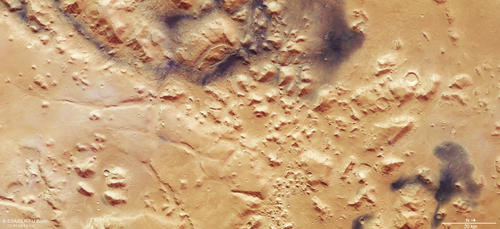From hills to valleys – material transport on Mars
The images show a hilly landscape scored through by a myriad of furrows. This area lies on what is known as Mars' dichotomy boundary, or sometimes as the highland-lowland boundary. The pronounced dichotomy between the crater-strewn highlands south of the equator and the smooth northern lowlands, is one of Mars' most striking topographical features. In most places, the transition between the two is marked by a steep terrain edge, with numerous inselbergs or outlier mountains at the foothill, which represent the remnants of the highlands and were able to withstand the processes of erosion for a longer period of time. Traces of glacier activity and ice can often be seen along the dichotomy boundary, indicating the presence of ice in the past.
The southern region, with its plateau-like rocks (on the left of the image), is significantly higher than areas further north (on the right of the image), which mainly consist of smaller mesas and hills. These are interspersed with depressions that formed through erosion processes during the planet’s past. Water and ice transported the rocky material downslope into areas of lower elevation millions of years ago. The narrow valleys bear particularly clear traces of these flow processes, with line-like structures that show where material was transported by water or ice. The elevations in the adjacent northern lowlands are testament to the former level of the terrain and are thought to consist of more resistant material.
One process still at play on the Martian surface is the transport of sand and dust by wind. Visible traces of this can be found in the depressions, which are filled with dark material. The dark sand is of volcanic origin and forms wide-ranging expanses of sand and dunes.
Some materials in the low-lying areas, especially in the western (upper) part of the image, show signs of alteration by water. Spectrometer experiments, e.g. OMEGA on board Mars Express, have detected clay minerals in this region, which have water molecules embedded into their crystal structure. The presence of these hydrous minerals has implications for the formation conditions and for the former climate on Mars.
